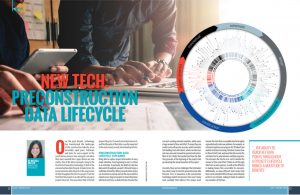New Construction Technology-Preconstruction Data Lifecycle
This article was written by Melissa Mullen, Marketing Specialist at Beck Technology, and published in the March/April 2020 edition of ©InFocus by TEXO.

Over the past decade, technology has transformed the landscape of the construction industry at an incredibly rapid pace. Software and tools for every aspect of the construction process have emerged, and ideas that once seemed like a pipe dream are now a reality.
One of the latest concepts rising to the forefront of innovative technology is that of the preconstruction data lifecycle.
The preconstruction data lifecycle is the progression of data throughout the life of a project, from the time that the project is an idea all the way up to project closeout. Preconstruction data lives in it and the lifecycle of that data is vastly important to the next project pursuit and estimating efforts.
What is the Preconstruction Data Lifecycle?
Being able to capture project information at every major milestone, from beginning to end, is critical to an estimator. The ability to track key data points throughout a project’s lifecycle brings a multitude of benefits.
When preconstruction teams can track data so closely and see the way in which it impacts every stage of a project, they can:
- Know what to do next time, or what not to do.
- Start creating estimate templates, saving a huge amount of time and effort.
- Predict costs with greater accuracy, building trust with clients, resulting in more wins and renewals for general contractors.
- Understand how the data generated at the beginning of the project ends up impacting the actual execution of the project.
Currently, there are two challenges that estimators face when trying to track the preconstruction data lifecycle. First, as innovative as the construction technology market has become, there aren’t many tools available that address this unique need.
Second, the tools that are available tend to be highly segmented and create new problems. For example, an estimator might use one 3D takeoff software and another software for historical costing. When it comes time for them to find, track, and move this data around, the estimator has to jump between multiple programs. This increases the risk of error, not to mention the amount of time and effort it takes to sift through data from so many sources, as well as the difficulty in making binary files accessible for everyone. Additionally, so many different tools means that there can be a hundred different ways everyone performs an estimate, making it harder to onboard new members of the team and provide consistency in deliverables.
Building Efficiencies and Insights
That’s where preconstruction data lifecycle tools come in. These tools get rid of the need for point solutions and instead consolidate multiple programs into one platform. This also eliminates binary files, instead offering an expansive database that every estimator can access at any time, drastically increasing efficiency and reducing error. It helps create a truly integrated preconstruction team and provides them with the assets they need to begin forecasting numbers and quantities, and ultimately, to then compare those predictions with the real thing and see how closely it measures up.
Capturing data in a standardized way does much more than just streamline a team’s workflow. It also makes other, equally important features, more attainable. For example, when preconstruction teams have a standard process in place to obtain data, it becomes that much easier to introduce automation and machine learning into the team’s daily workflow. AI-powered computer learning can take all the data from all the estimates in the team’s database and then use that data to inform the team of the best outcomes for a project.
But perhaps the most important benefit that a preconstruction data lifecycle tool offers to estimators is that of deeper analysis. Analysis is the lifeblood of preconstruction. Anyone can come up with some fast figures, but only a good estimator will be able to take it a step further and analyze the numbers so they can better understand their meaning in relation to the project.
The ability to analyze estimate numbers means that the preconstruction team can make more accurate predictions, provide a better project estimate to project owners, and improve their predictions for the future, instead of having to take a shot in the dark.
“Now that we’re able to provide a truly integrated platform to consumers, the next real benefit is the capturing of data in a standardized way, and then being able to give them the data over time to make better, more informed decisions,” said Stewart Carroll, President of Beck Technology. “To me, that’s the real long-term value – access to the data. Once you have data in a standardized and accessible format, that’s when you can start leveraging newer technologies like machine-learning and AI.”
Clarity and Collaboration
In addition to being able to analyze project-related numbers, it’s also crucial for estimators to understand what is happening to their data throughout the life of a project. When they begin working with architects, do their predictions align with reality? Does cost go up significantly, and if so, by how much? What happens to a preconstruction team’s fees – do they get eroded? Being able to answer all these questions is game-changing for a preconstruction team, and that’s exactly what a preconstruction data lifecycle aims to do.
Another key feature that estimators need to have access to is being able to search for a specific line item and look at its individual cost history. “Some people want to know what an individual line item, such as material for floor tiles, costs on the last five or six projects,” said Stewart. “Typically, that’s a guessing game. But with a preconstruction data lifecycle tool, a user can see that cost history, and adjust for regional and time differences as well.”
Having access to this amount of data means that preconstruction teams can get a better picture of the current project they’re working on by referencing data points from previous projects. It also enables them to continue improving their predictions with every project they take on.
Affects Recruitment and Retention
Preconstruction data lifecycle tools also positively impact estimators when it comes to recruiting new talent. Younger potential hires fresh from college are often drawn to companies that don’t just talk about innovation but live it out. Adopting an integrated system that addresses every stage of a project is on the cutting edge of innovation today. It is also a boost to senior preconstruction professionals who are looking for career advancements.
Joining a company who values the preconstruction data lifecycle and the benefits that come along with digesting that data is gold to experienced professionals.
Using these tools ensures greater standardization across a preconstruction team, meaning that it’s less likely for important data to be siloed to one person, and more likely to encourage collaboration across multiple offices. It also makes it easier to bring on new talent – with standards in place, onboarding flows much more smoothly.
Looking at the Future
The benefits of the preconstruction data lifecycle don’t just stop at the company and the employees. The built environment also reaps the advantage. When the design and construction industries make better decisions then the buildings we work and live in as well as the infrastructures we rely on are better. The preconstruction data lifecycle has a greater impact on our world than just the one we have built at our desks.
By having access to data that has been hidden or out of reach for years allows the companies that develop our communities to enhance their project insights, work collaboratively on decisions that really matter, and do so with a confidence that comes with years of experience. Now that experience has tangible preconstruction facts and figures to support moving our industry in the right direction.

-1.png?width=112&height=112&name=image%20(4)-1.png)













